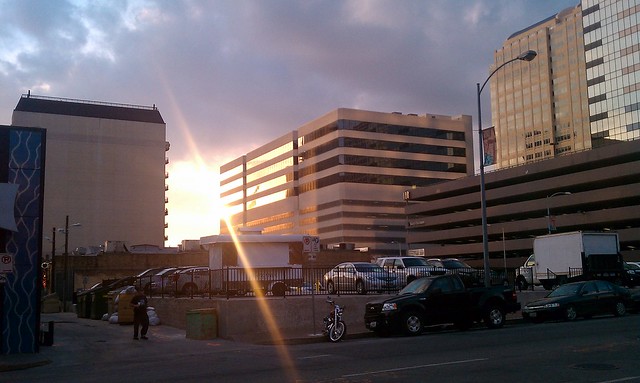As we walked out of Frank last week, I couldn’t help but notice this view. There’s nothing particularly dramatic about it. What is interesting, to me at least, is that for years this view didn’t exist.
201 E 5th Street obstructed the view to 5th Street from this block of Colorado St. That building was recently razed, and was replaced with a surface level parking lot. Eventually, the “1 Hotel” is supposed to occupy the land once they find the capital to commence with site permitting and construction.
Until then, the open space replaces a vacant and ugly building. I’m usually against taking down a building of higher and better use and replacing it with a surface level parking lot. But in this instance I’m ambivalent. Now, the “energy” at 5th @ Colorado, a gateway into downtown Austin’s Warehouse District, just feels good… better.
It’s more inviting to see through to Colorado St, rather than walk around what was a “dead” building. A completed “1 Hotel” would energize the district, but until that time, this surface level parking lot is better than what it replaced.
-Jude

This “land banking” stinks. There should be a fee or penalty for creating this type of urban blight.
The tax code definitely needs to change. There should be like a 36 month tax abatement after tearing down a building in the CBD core of downtown. If you tear down a building you get the tax break for a while, say 36 months. After 36 months if new construction has not begun in earnest the sites property taxes revert back to what they were when there was a structure on them.
That would at least make property owners think twice before tearing down older buildings which could still serve some function.
I could not disagree with you more. Over the past few years I have seen numerous surface parking lots develop from my perch in the 360 condo. The owners of the buildings let them deteriorate and then rip them down, banking the land. The tax system is structured to encourage this and the city permitting process is structured to encourage this. Land owners in the downtown are gutting the urban fabric, the pattern of buildings of various ages, sizes and shapes that help encourage vitality. I would have much preferred that the boring building remained–it could have maintained the urban fabric, provided event space and inexpensive office space. Instead, we have yet another bland surface parking lot. Downtown is starting to look rather suburban in places.
A sea of asphalt does not a destination make.
I knew this would stir things up 🙂
Admittedly, I was a little uncomfortable publishing a notion that on its surface stands in opposition to urbanist principals. I’ve also witnessed what you describe, and agree with you that the tax system is structured to encourage this and the city permitting process is structured to encourage this.
I’m very clear that this post doesn’t intend to generalize. I wanted to point out that it is not 100% of the time that a building, especially an ugly and poorly designed building, contributes to good urban landscape.
In this specific instance the resulting intermediate step – a parking lot before a hotel is built – is just does not that bad.
I’d hesitate to call a paved surface lot “open space,” as that term usually implies grass and/or trees. I will be surprised if it’s not several years before a building is put on that site.